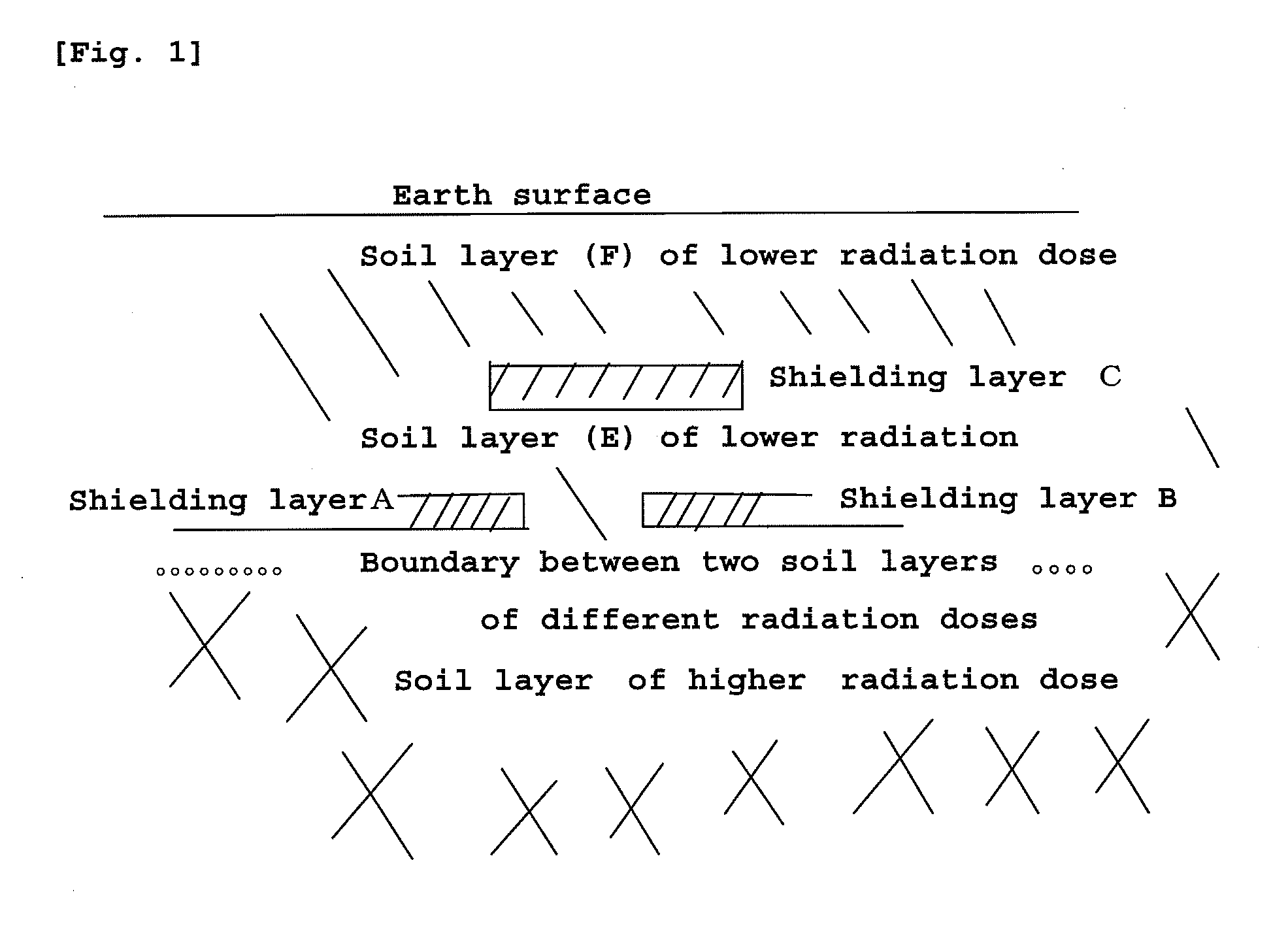Shielding material used for shielding of radiation and method for shielding a radiation emitted from earth surface using the shielding material
- Summary
- Abstract
- Description
- Claims
- Application Information
AI Technical Summary
Benefits of technology
Problems solved by technology
Method used
Image
Examples
example 1
Comparative Examples 1 and 2
[0072]100 parts by weight of butyl rubber and 250 parts by weight of barite were compounded using an open roll to produce a rubber sheet of 18 mm in thickness as a shielding material. In Example 1, this sheet was placed on the earth surface of measurement site and a measurement was made thereon. In Comparative Example 1, a measurement was conducted at the same position as in Example 1 without using the rubber sheet. In Comparative Example 2, a measurement was conducted in other measurement site of different radiation dose without using the rubber sheet, for comparison.
TABLE 1-1Formulation of rubber sheetButyl 268 (1)100 parts by weightBarite (2)250 parts by weight
TABLE 1-2ComparativeComparativeExample 1Example 1Example 2(4)(5)(6)Measured radiation85~109201~2430~12dose (3)(unit: CPM)
Notes
[0073](1) Butyl 268 produced by Japan Butyl Co., Ltd.[0074](2) Barite BC produced by Sakai Chemical Industry Co., Ltd.[0075](3) A value obtained by subtracting 50 CPM (bac...
example 2
Comparative Example 3
[0082]70 parts by weight of butyl rubber, 30 parts by weight of EPDM and 200 parts by weight of sand iron were compounded using an open roll to produce a rubber sheet (the formulation is shown in Table 2-1) of 16 mm in thickness as a shielding material. In Example 2, this sheet was placed on the earth surface of measurement site and a measurement was made thereon. In Comparative Example 3, a measurement was conducted at the same position as in Example 2, using no rubber sheet.
TABLE 2-1Formulation of rubber sheetButyl 268 (1)70 parts by weightEP 33 (2)30 parts by weightSand iron (3)200 parts by weight
TABLE 2-2Example 2Comparative(5)Example 3 (6)Measured radiation98~119153~208dose (4)(unit: CPM)
Notes
[0083](1) Same as (1) of Example 1[0084](2) An ethylene-propylene rubber containing ethylidene norbornene as a diene component and having an iodine value of 26.0, produced by Japan Synthetic Rubber Co., Ltd.[0085](3) A sand iron for experiment, marketed by Kajidai Tek...
examples 4 and 5
Comparative Example 5
[0101]A formulation of Table 4-1 was compounded using an open roll to produce a rubber sheet of 9 mm in thickness. Sand iron or barite was placed in a thickness of 18 mm, as an intermediate material, between two of the produced rubbers. In Examples 4 and 5, this combined shielding material was placed on an earth surface and a radiation dose was measured thereon. In Comparative Example 5, the measurement of radiation dose was made without using the combined shielding material. The results are shown in Table 4-3.
TABLE 4-1Formulation of rubber sheetButyl 268 (1)100 parts by weightBarite (2) 30 parts by weightHYK talc (3)100 parts by weightCalcium bicarbonate (4) 70 parts by weight
TABLE 4-2Intermediate material placed between two rubber sheetsExample 4Example 5Sand iron (5)——Barite (2)
TABLE 4-3ComparativeExample 4Example 5Example 5Measured radiation91~134102~124462~480dose (6)(unit: CPM)
Notes
[0102](1) and (2) Same as (1) and (2) in Example 1[0103](3) HYK talc of Fuj...
PUM
| Property | Measurement | Unit |
|---|---|---|
| Fraction | aaaaa | aaaaa |
| Percent by mass | aaaaa | aaaaa |
| Percent by mass | aaaaa | aaaaa |
Abstract
Description
Claims
Application Information
 Login to View More
Login to View More - R&D
- Intellectual Property
- Life Sciences
- Materials
- Tech Scout
- Unparalleled Data Quality
- Higher Quality Content
- 60% Fewer Hallucinations
Browse by: Latest US Patents, China's latest patents, Technical Efficacy Thesaurus, Application Domain, Technology Topic, Popular Technical Reports.
© 2025 PatSnap. All rights reserved.Legal|Privacy policy|Modern Slavery Act Transparency Statement|Sitemap|About US| Contact US: help@patsnap.com


